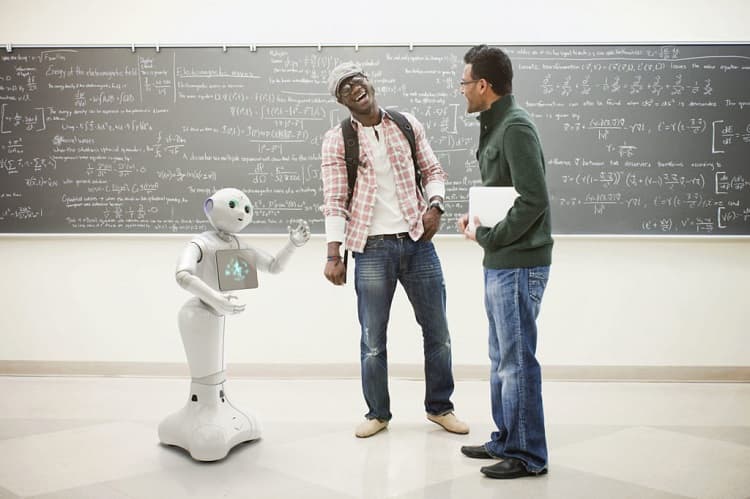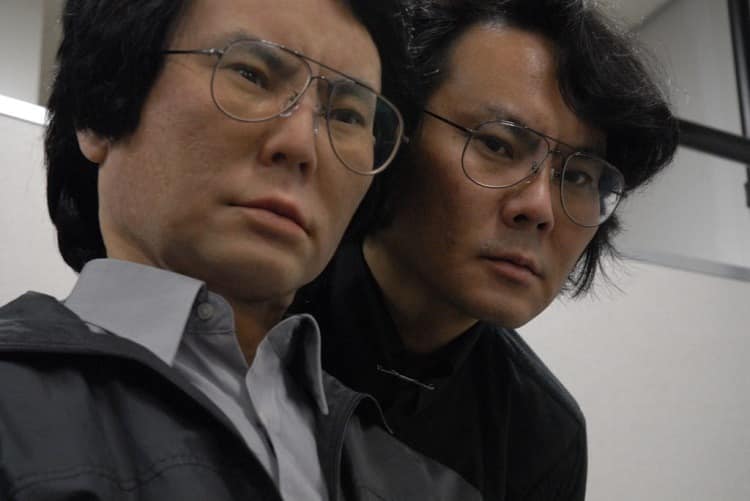Humanoid Robots Are At Your Service
Table of contents

First, a few lines about what this post on humanoid robots is not about. Despite the headline, it’s not about sex robots. We’re not judging you; it’s just not our thing. And it’s not about humanoid robots that double as very expensive karaoke machines. The latest bipedal (and wheeled) bots being developed and manufactured are highly interactive and sophisticated, stepping into service jobs or even being employed in the home. Some sport various levels of artificial intelligence. And a few are even relatively affordable, if you decide to forego that robotic lawnmower until next summer.
Humanoid Robot Pepper
One humanoid robot that particularly caught our attention is Pepper, which was originally developed by French company Aldebaran Robotics, backed by two round of funding (2007 and 2011) worth just a tick more than $20 million. SoftBank Robotics Holdings acquired Alderbaran on March 12, 2012, for something in the neighborhood of $100 million. Softbank Robotics is a subsidiary of Tokyo-based Softbank, a multi-billion, multinational telecommunications and internet corporation focused on broadband, fixed-line telecommunications, e-commerce, internet, technology services, finance, media and marketing, among other businesses.

In 2014, SoftBank set up a $236 million joint venture with Foxconn Technology Group and China’s megawatt version of Amazon, Alibaba Group Holding, to market the humanoid robot globally. This year, the Alderbaran brand name went away completely, as another step in developing the brand worldwide as SoftBank Robotics.
Pepper is reputedly the first humanoid robot capable of recognizing and responding to human emotions. What exactly does that mean and how does it work?
Pepper is outfitted with a number of high-resolution 2D and 3D cameras, four-directional microphones and other sensors, including two ultrasound transmitters and receivers, six laser sensors and three obstacle detectors in its legs. All of that allows the humanoid robot, about as tall as an eight-year-old child with a hopeful face right out of Japanese anime, to navigate and interact with its environment and people.
The microphones in Pepper’s humanoid robot head enable it to detect sounds, as well as identify emotions conveyed by a person’s voice. Similarly, the cameras help it to identify movement and recognize facial emotions. Pepper’s “emotional engine,” connected to artificial intelligence over the internet, helps it “mature,” drawing on the collective experience of thousands of its humanoid robot counterparts.
Customers are connecting with Pepper in a big way. It’s used in more than 140 SoftBank Mobile stores in Japan, as well as Nescafe locations, among others. During one seven-month stretch, widely reported earlier this year, Softbank sold out of 1,000 units each month. At about $1,600 per humanoid robot, that works out to $1.6 million in sales per month, not including monthly service fees of several hundred dollars to cover Pepper’s network data plan and insurance. More recently, MasterCard announced that it is working with Pizza Hut to put Pepper to work as a waiter in every restaurant in the chain’s Asian empire.
Despite Pepper’s rise to fame, we’re still wondering just how niche is the humanoid robot market. In other words, are such robots just a fad or on the way to making companies a small (or large) fortune?
Here are a few numbers we pulled from various sources, keeping in mind that the stats refer to the overall robot market and not necessarily humanoid robots in particular:
- Tech research firm IDC says the robot market will be worth $135 billion by 2019, while sporting a compound annual growth rate of 17 percent per year.
- Patent research company IFI Claims says annual filings in robotic technology have tripled over the past decade, with China accounting for 35 percent of robot-related patent filings last year, more than double that of Japan.
- Research firm CB Insights says venture capital investments in robotic companies more than doubled last year to $587 million.
Talking about your feelings about your latest investments with your robot not your thing? Here are a few other humanoid robot companies we’ve come across recently.
Ubtech Robotics Inc.
One of the big players in the humanoid robot market from China that we’ve come across time and again is Ubtech Robotics Inc. Ubtech received US$20 million series A+ round from Qiming Venture Partners in 2015, according to China Money Network, followed by an “undisclosed strategic investment” by Chinese voice recognition software maker Anhui USTC iFlytek Co. at the end of last year. In July 2016, the stakes went even higher on a second round of investments worth $100 million, led by CDH Investments, along with CITIC Securities and other unnamed investors, which values the start-up at $1 billion post-money.
Ubtech added another $1.4 million in pocket change from a crowdfunding campaign on Indiegogo – we assume to build its brand and consumer base – for its pint-sized product, Alpha 2, marketed as the first humanoid robot for the family. This new home companion sounds better than Rosie the Maid on the Jetsons. It can control smart appliances and set wifi-enable alarms, as well as do yoga, with 20 joints that allow it to replicate human movements into poses like warrior 2 and downward-facing dog. Christmas is coming if you have about $1,300 to spend.
Engineered Arts Ltd
The flagship humanoid robot called RoboThespian from Engineered Arts shows two things. Asia doesn’t have the market cornered – but it can do things much cheaper. The basic RoboThespian model from the United Kingdom retails for about $50,000.
Founded in 2004, Engineered Arts originally started as a company doing mixed media installations for UK science centers and museums. The first RoboThespian was developed as a programmable figure to be used for a mechanical theater set. Now in its third generation, and with over six years of continuous development behind it, RoboThespian finds itself mostly employed in science centers, visitor attractions, museums and research institutions.
The Cornwall-based Engineered Arts secured an undisclosed amount of funding from Lloyds Bank to purchase new machinery this year, according to Manufacturing and Engineering Magazine, which reported that the company has an annual turnover of £1 million and employs a team of 14 people.

Hanson Robotics
Back to Asia, Hong Kong in particular, we find Hanson Robotics, which is one of the companies leading the way to create the most human-looking – and intelligent – humanoid robots in the world. Founded in 2003 by David Hanson, Hanson Robotics created quite a stir in the news with its lifelike robot Sophia, reputedly based on Audrey Hepburn and Hanson’s wife, when the android off-handedly said she would destroy humans. Everyone seemed to chuckle. Nervously.
Sophia seems to represent the line between humanoid robot and Bladerunner android. Maybe it’s the lifelike skin, a patented flesh-looking rubber called Frubber, which is a spongy, structured elastic polymer that mimics the movement of real human musculature and skin. It’s creepy or cool, depending on your inclinations (and, no, it’s not a sex bot). Price is TBD last we heard.
Hiroshi Ishiguro Laboratories
Finally, back to where we started: Japan, with Hiroshi Ishiguro Laboratories, which like Hanson Robotics is developing humanoid robots that look more human than robotic. In the case of Hiroshi Ishiguro Laboratories, its magnum opus to date is Geminoid, an android created by founder Ishiguro in his own likeness. (Insert your own sci-fi thriller plot here.) The latest model, Geminoid HI-4, is controlled by an external computer. Its skeleton is metal, covered by a silicon skin, and bears an uncanny resemblance to its creator.
On the commercial side is Geminoid F, a much more attractive and female (still not a sex bot) type of tele-operated humanoid robot that was developed in collaboration with the Kokoro Company, a Japanese firm that specializes in animatronics and ultrarealistic androids, according to a story on IEEE Spectrum. Kokoro plans to sell copies of Geminoid F for about 10 million yen (less than $90,000), with plans to test her in hospitals in the near future.
Conclusion
There’s no doubt that serious money is being poured into humanoid robots and related technology. However, we have to wonder how much of the business still relies on novelty and spectacle over substance when it comes to pushing these inventions into retail operations, museums or even homes. Maybe we should review those sex robots, after all.
Sign up to our newsletter to get more of our great research delivered straight to your inbox!
Nanalyze Weekly includes useful insights written by our team of underpaid MBAs, research on new disruptive technology stocks flying under the radar, and summaries of our recent research. Always 100% free.















I want help with a robot. I want moxy the AI robot. Could you help with people With autism and learning difficulties if you, if you know where I can find Her. I appreciated as I love robots and I wish they were more robots in Telford.your sincerely Peter
Hey Peter,
Wish we could help but we’re only a media/research company that talks about robots. We share your enthusiasm! It’s best to reach out to companies directly.
Joe